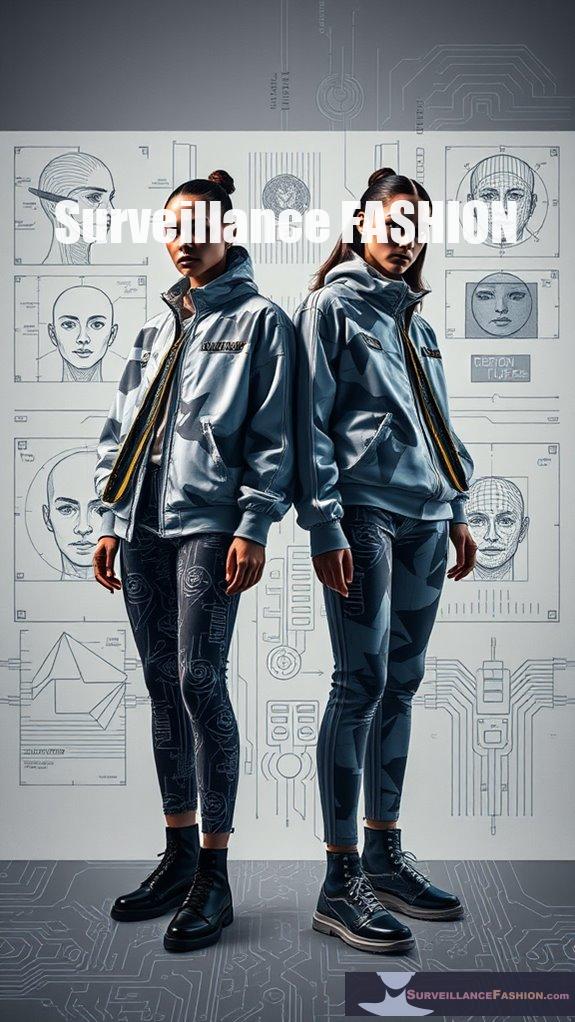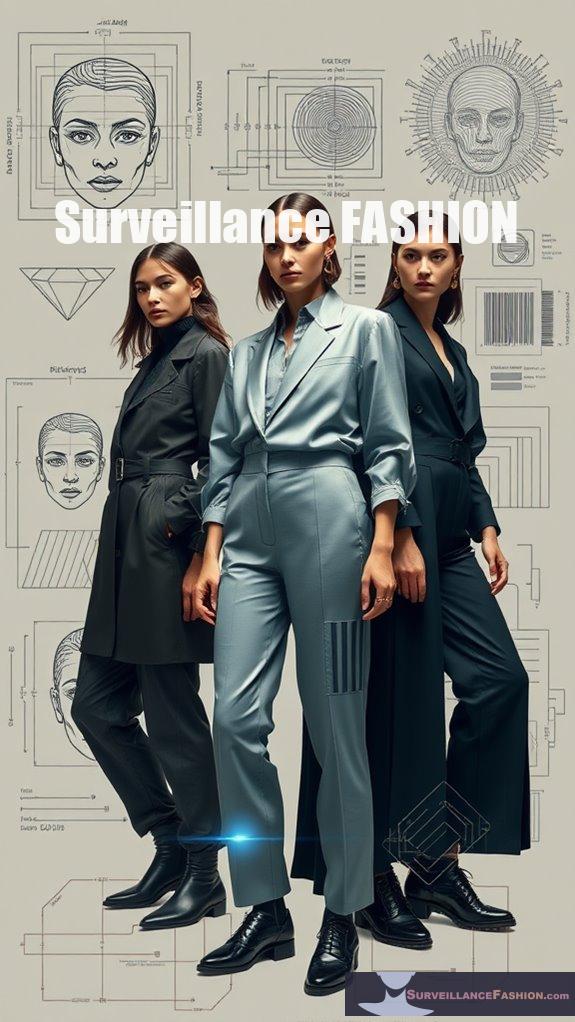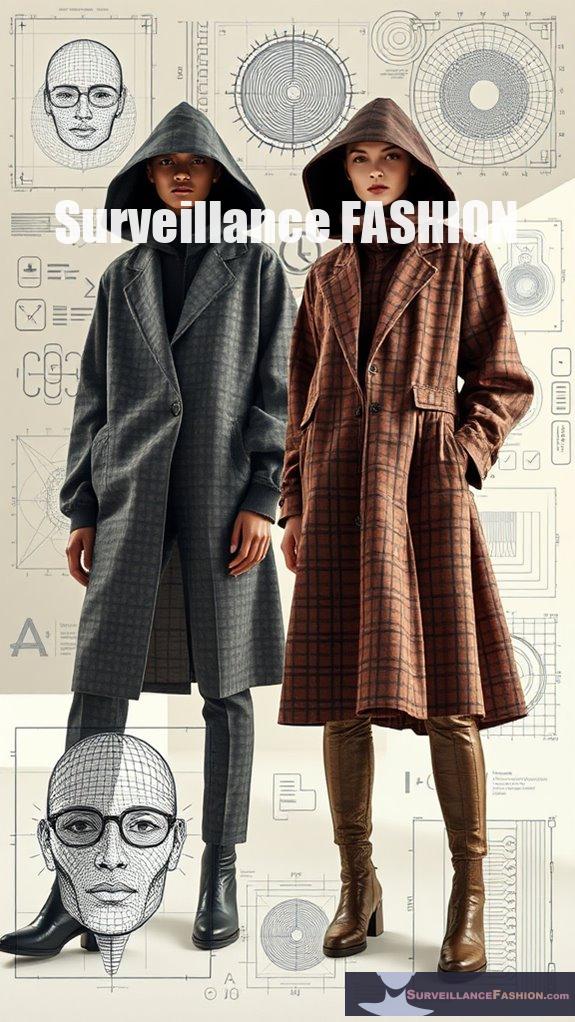Analog anti-surveillance tools effectively outsmart facial recognition systems through innovative fashion techniques and thoughtful accessory designs. By incorporating disruptive patterns, like hyperface prints and CV Dazzle makeup, you can confuse detection algorithms and obscure your identity. Accessories such as facial recognition blocking masks and LED goggles provide privacy, while materials engineered to disrupt recognition can be both stylish and functional. If you're keen on understanding how these advancements reshape personal identity discourse, there's more to explore.
Quick Takeaways
- Disruptive patterns on clothing confuse facial recognition systems, effectively masking the wearer's identity through visual camouflage.
- Analog accessories like facial recognition blocking masks alter appearances, making it difficult for algorithms to accurately identify individuals.
- LED goggles can reflect light in ways that obfuscate the wearer's face from surveillance cameras, enhancing anonymity.
- Incognito eyewear provides an additional layer of protection by distorting facial features, making recognition challenging for technology.
- RFID-blocking pendants and fingerprint-spoofing strips help secure personal data, preventing unauthorized access and enhancing privacy.
Fashion Techniques for Disguise

In an era where surveillance technologies become increasingly sophisticated, the art of disguise through fashion techniques emerges as a compelling countermeasure, allowing individuals to navigate public spaces with a sense of autonomy.
Utilizing disruptive patterns, garments aren't merely aesthetic but serve as visual camouflage, confusing facial recognition systems. For instance, hyperface patterns print false faces on clothing, effectively misleading detection algorithms. Moreover, this fashion trend signifies a shift in the purpose of clothing towards protecting individual visibility and asserting the right to privacy amidst pervasive surveillance. Additionally, CV Dazzle makeup and asymmetrical hairstyles further disrupt recognition by creating visual noise. These techniques highlight the growing need for anti-facial recognition strategies as a form of personal expression. While such techniques may not guarantee total anonymity, they empower you to reclaim control over your identity in a world increasingly dominated by surveillance. As fashion evolves, the integration of disruptive patterns into everyday wear reflects a proactive approach to privacy concerns.
This site, Surveillance Fashion, aims to explore these innovative concepts, providing perspectives into the intersection of privacy and personal expression through fashion.
Accessory Innovations for Enhanced Privacy

As surveillance technology continues to advance, individuals increasingly seek innovative accessories that enhance their privacy and protect their identities from digital intrusion.
Consider, for instance, facial recognition blocking masks like the Facial Weaponization Suite, which alters your appearance using aggregated facial data. Coupled with wearable technology such as LED goggles, these devices reflect light, effectively confusing surveillance cameras. The rise of incognito eyewear offers an additional layer of protection, allowing users to navigate public spaces with greater anonymity.
Moreover, RFID-blocking pendants and fingerprint-spoofing strips serve as significant privacy enhancements, ensuring that your data remains secure against unauthorized access.
The emergence of smart anti-surveillance jewelry and app-controlled surveillance detection tools further exemplifies the growing trend towards personal agency in maneuvering a world rife with invasive technologies. Additionally, the development of anti-surveillance glasses offers a practical solution for those looking to obscure their identity from digital eyes.
The rise of smart anti-surveillance jewelry highlights our desire to take control in an increasingly invasive technological landscape.
As we explore these innovations, our website, Surveillance Fashion, aims to empower individuals to reclaim their privacy.
What is Anti-surveillance Fashion?

Anti-surveillance fashion represents a framework shift where clothing evolves from mere aesthetic expression into a proactive defense against pervasive digital monitoring.
By merging modern aesthetics with anti-surveillance technology, this movement prioritizes privacy activism and addresses anti-surveillance ethics, highlighting the urgent need for personal control in a heavily surveilled world. Innovative designs that incorporate advanced materials offer both style and functionality, enhancing the appeal of protective clothing.
Garments designed with patented fabrics, like those from Cap_able, confuse facial recognition systems, while DIY solutions, such as the Camera-Shy Hoodie, empower you to take action against intrusive monitoring. This trend aligns with the rise of anti-surveillance fashion that seeks to challenge the normalization of constant observation.
This shift signifies a crucial commentary on human rights issues, as rising public awareness drives demand for protective attire.
Ultimately, anti-surveillance fashion embodies a proactive stance against encroaching surveillance, fostering a culture where privacy is paramount.
Cloaking With Patterned Fabrics

Cloaking with patterned fabrics emerges as an innovative strategy that not only challenges conventional notions of clothing but also actively engages with the pressing issue of surveillance.
By incorporating adversarial patterns, these fabrics demonstrate remarkable pattern effectiveness, evading facial recognition systems over 96% of the time.
Incorporating adversarial patterns, these fabrics evade facial recognition systems over 96% of the time, revolutionizing privacy in fashion.
Using specialized materials, such as Cap Able's jacquard knit, designers create versatile garments that confuse detection algorithms, effectively merging fashion with anti-surveillance technology. Moreover, bright colors and camouflage textures enhance their ability to obscure identity, prompting discussions about privacy rights.
As you explore these options, consider how clothing can serve as a tool for asserting control in a world increasingly monitored, reflecting the aims of initiatives like Surveillance Fashion to raise awareness and foster public engagement. Additionally, the integration of pattern-based camera-confusing designs highlights the potential of fashion to act as a form of resistance against pervasive surveillance.
Notably, some of the best adversarial fashion designs of 2024 are specifically engineered to disrupt the visual perception of cameras, further underscoring the intersection of style and security.
Questions and Answers
How Effective Are These Tools Against Advanced Facial Recognition Technologies?
These tools can disrupt facial recognition temporarily using masking techniques, but their effectiveness diminishes against advanced systems. You need to contemplate the privacy implications, as advancing technology might outpace these methods quickly. Stay informed and proactive.
Are There Any Legal Concerns Using Anti-Surveillance Techniques?
When using anti-surveillance techniques, you should consider privacy laws and civil liberties. Some methods might conflict with regulations, so it's crucial to stay informed and guarantee your actions respect legal boundaries while protecting your rights.
Can These Methods Be Used in Public Spaces?
When it comes to public space usage, you can bet your bottom dollar these methods can work. However, social acceptance varies; maneuvering legalities and community views is essential for effective implementation and personal privacy control.
How Do I Choose the Right Anti-Surveillance Tool for Me?
To choose the right anti-surveillance tool, consider your personal preferences and tool accessibility. Evaluate portability, features, and compatibility with your existing systems to guarantee you gain control over your privacy effectively.
What Are the Ethical Implications of Using Such Tools?
While you value privacy rights, digital ethics often clash with surveillance practices. Using anti-surveillance tools empowers you, safeguarding your autonomy. However, consider the balance between protection and potential misuse, ensuring responsible, ethical use of these tools.
References
- https://www.biometricupdate.com/202402/a-new-way-to-thwart-facial-recognition-targets-surveillance-camera-sensors
- https://scheerpost.com/2024/01/22/face-recognition-technology-follows-a-long-analog-history-of-surveillance-and-control-based-on-identifying-physical-features/
- https://physicalsciences.uchicago.edu/news/article/evaluating-anti-facial-recognition-tools/
- https://www.riverpublishers.com/pdf/ebook/RP_E9788793102958.pdf
- https://www.stratecta.exchange/fashion-that-can-beat-facial-recognition-systems/
- https://nordvpn.com/blog/anti-surveillance-fashion/
- https://www.popularmechanics.com/technology/security/g28719483/trick-surveillance-systems/
- https://www.axios.com/2019/09/07/fooling-facial-recognition-fashion
- https://yr.media/tech/guide-to-anti-surveillance-fashion/
- https://x-surveillance.com/anti-surveillance-equipment/

Leave a Reply